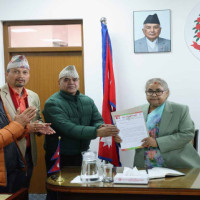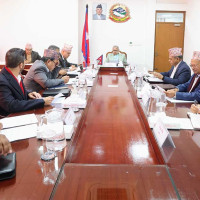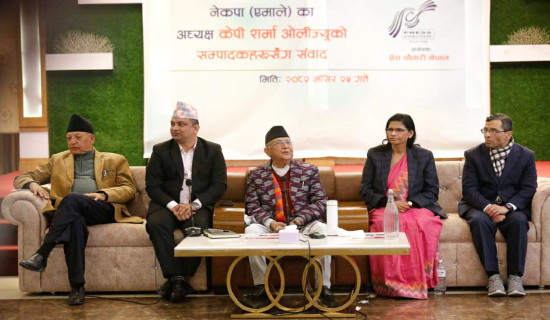- Thursday, 11 December 2025
Redesign safer highways to minimise wildlife accidents: Experts
Chitwan, July 28:The Barandabhar Biological Corridor features dense forest areas with various wildlife inhabiting the jungle. However, the Barandabhar-Parsa section under the East-West Highway, has seen a significant number of wildlife deaths due to road accidents, highlighting the urgency for elevated road there.
In recent years, the Pathlaiya-Amlekhgunj road section has been particularly deadly, with Parsa National Park recording 42 animal deaths in the fiscal year 2018/19, including species like spotted deer, blue bull, and wild boar.
Similarly, during the fiscal years 2016 to 2018, a total of 60 animals were killed by vehicles in Parsa, with 75 per cent of these incidents occurring on the Pathlaiya-Amlekhgunj stretch. These incidents highlight the dangers for wildlife as the East-West Highway passes through five wildlife conservation areas in the Tarai region.
Conservationist Roshan Sherchan noted that the Barandabhar Biological Corridor is one of the most frequently used corridors by wild animals, including elephants, tigers, rhinos, and many others travelling between Chitwan National Park and Mahabharat via the Chure range.
Sherchan warned that the number of wildlife accidents might increase after the expansion of the highway to four lanes, designed to meet the standards of the Asian Highway. “High-speed vehicles pose a significant risk to wild animals crossing the road, as the corridor is a traditional path for them to move from one place to another,” Sherchan added.
The proposed elevated road will help mitigate the impact of the East-West Highway on the animals in Parsa and this will provide a crucial passage for animals whose movement has been hampered by the highway acting as a barrier, he added.
According to the Department of National Parks and Wildlife Conservation, around 200 km of the 1,028-km East-West Highway runs through national parks that are important tiger habitats. Banke National Park has 100 km of highway, Bardiya has 30 km, Parsa 20 km, Shuklaphanta 8 km, and the buffer zone of Chitwan National Park has 5 km.
Even though there are underpasses on the Pathlaiya-Amlekhgunj stretch, some are narrow, and others are piled with litter. One underpass constructed in Barandabhar during the construction of the highway is also covered with litter. Recently, with the support of World Wildlife Conservation (WWF) and the initiative of the Department of National Parks and Wildlife Conservation, a new underpass has been constructed focusing on wildlife crossing.
The government introduced its first policy guidelines on the construction of wildlife-friendly infrastructure in 2021. The policy guidelines aim to address the challenges of balancing development with conservation efforts, which also opens new concepts to address conservation along with development.
The concept of building elevated roads within Parsa National Park and Barandabhar, which are the hotspots for wildlife crossing, is under discussion now. Shova Giri, assistant director at an Asian Development Bank-funded project to improve road networks across South Asia, said that the project was working on plans to expand the eastern section of the East-West Highway, including the Amlekhgunj-Pathlaiya section.
“Within the 29 kilometres forest patch, we are planning to construct two elevated roads of two kilometres each – one in Parsa National Park and another in Barandabhar, the main crossing point of wild animals,” she said.
Implementing elevated roads in the Barandabhar-Parsa section is a forward-thinking solution that addresses the dual goals of development and conservation.
As Nepal continues to grow and develop its infrastructure, it is imperative to adopt innovative methods that protect its unique and irreplaceable natural heritage, experts said.
Shova Chhetri of WWF stressed the importance of constructing a wildlife-friendly infrastructure. “The Barandabhar Biological Corridor is the traditional movement trail for wild animals, and while infrastructure development is necessary, it is crucial to do so in a way that conserves both human and natural environments, ensuring they can be safely handed down to future generations,” Chhetri said.
Elevated roads represent a strategic investment in the future, ensuring that the Barandabhar Corridor Forest remains a vibrant and thriving habitat for generations to come.
















